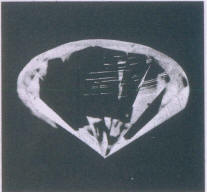Almost every cut diamond shows polishing marks, but they are mostly so fine that they can only be seen with difficulty. They occur in the form of cutting traces or polishing lines and are the result of a diamond's hardness being dependent on direction. Cutting traces may be seen on an unpolished facet.
Polishing lines occur as scarcely visible fine lines, or clearly visible ones, or in the form of easily seen hatching. As the hardness of diamond depends on direction, many facets are particularly "hard" and can only be polished with difficulty. Cutting traces and polishing marks occur, therefore, in the same direction only on one facet, as the cutter can set only one facet on the scaife at one time.
Thus the direction of polishing marks alters from one facet to another; they stop at the boundary of the facet and do not continue in the same direction over two facets (Fig 344). Polishing marks on the table of a brilliant are most easily seen through the pavilion. From here they appear through the cone formed by the pavilion, as slightly curved (Fig 345).
| Fig 343 a Polishing lines are most easily discernable when viewed from the opposite side of the brilliant |
 |
 |
 |
| Fig 344 Fine polishing lines on pavilion facets seen through the table | Fig 345 Polishing lines on the table are most easily discernable when viewed through the pavilion |
 |
 |
| Fig 346 Polishing lines on the table - in direct light | Fig 347 Polishing lines on the table - seen through the pavilion |
From above, polishing marks are most easily perceived if the relevant surface is held obliquely to the light source, so that the marks become visible in the reflected light.
Polishing lines on the pavilion are most easily seen through the table.
Knots
Tiny knot-like irregularities on the surface are called knots. They usually arise from an inclusion reaching the surface, which can only be polished with difficulty or by structural inhomogenities. Consequently, knots are usually accompanied by a few polishing lines.
Burn marks
Burn marks are caused by the generation of excessive heat during cutting and polishing of diamonds. They appear as light milky patches or "icy spots" on the facets; more rarely a scarred surface, marked by tiny pits, can be seen. Burns can also occur subsequently on a mounted diamond which has been over-heated during soldering. They can be removed by re-polishing, with little loss of weight.
| Indentations, damage to edges, scratches | Cut Grading of Fancy Cuts |